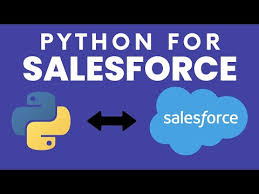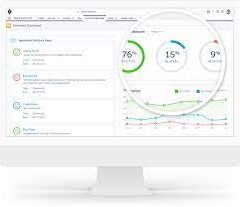Salesforce can integrate with Python, though the platform primarily relies on its proprietary languages and frameworks for core development. Python, however, plays a crucial role in enhancing Salesforce’s capabilities through integrations, automation, data analysis, and extending functionalities via external applications. Here’s an overview of how Python works within the Salesforce ecosystem:
1. Salesforce’s Core Development Stack
Before exploring Python’s use, it’s important to understand the key development tools within Salesforce:
- Apex: A proprietary, object-oriented programming language similar to Java, used for creating custom business logic.
- Visualforce: A framework for building custom UIs using a markup language akin to HTML.
- Lightning Web Components (LWC): A modern framework for building responsive web components using standard web technologies like JavaScript, HTML, and CSS.
These tools are the foundation for Salesforce development. However, Python complements Salesforce by enabling integrations and automation that go beyond these native tools.
2. Python in Salesforce Integrations
Python shines when integrating Salesforce with other systems, automating workflows, and extending functionality. Here’s how:
a. API Interactions
Salesforce’s REST and SOAP APIs allow external systems to communicate with Salesforce data. Python, with its powerful libraries, is excellent for interfacing with these APIs.
Key Libraries:
simple-salesforce: Simplifies interactions with Salesforce’s REST API.requests: A robust library for making HTTP requests to Salesforce APIs.zeep: Ideal for working with Salesforce’s SOAP API.
Example: Extracting Data via API:
pythonCopy codefrom simple_salesforce import Salesforce
# Connect to Salesforce
sf = Salesforce(username='your_username', password='your_password', security_token='your_token')
# Query Salesforce data
accounts = sf.query("SELECT Id, Name FROM Account LIMIT 10")
for account in accounts['records']:
print(account['Name'])
b. Data Processing and Analysis
Python’s data manipulation libraries like Pandas and NumPy make it ideal for processing Salesforce data.
Example: Data Cleaning and Analysis:
pythonCopy codeimport pandas as pd
from simple_salesforce import Salesforce
# Connect to Salesforce
sf = Salesforce(username='your_username', password='your_password', security_token='your_token')
# Fetch data
query = "SELECT Id, Name, AnnualRevenue FROM Account"
accounts = sf.query_all(query)
df = pd.DataFrame(accounts['records']).drop(columns=['attributes'])
# Process data
df['AnnualRevenue'] = df['AnnualRevenue'].fillna(0)
high_revenue_accounts = df[df['AnnualRevenue'] > 1000000]
print(high_revenue_accounts)
3. Automation and Scripting
Python can automate Salesforce-related tasks, improving productivity and reducing manual effort. This can involve automating data updates, generating reports, or scheduling backups.
Example: Automating Data Backup:
pythonCopy codeimport schedule
import time
from simple_salesforce import Salesforce
def backup_salesforce_data():
sf = Salesforce(username='your_username', password='your_password', security_token='your_token')
query = "SELECT Id, Name, CreatedDate FROM Contact"
contacts = sf.query_all(query)
df = pd.DataFrame(contacts['records']).drop(columns=['attributes'])
df.to_csv('contacts_backup.csv', index=False)
print("Salesforce data backed up successfully.")
# Schedule the backup
schedule.every().day.at("00:00").do(backup_salesforce_data)
while True:
schedule.run_pending()
time.sleep(1)
4. Building External Applications
Using platforms like Heroku, developers can build external applications in Python that integrate with Salesforce, extending its functionality for custom portals or advanced analytics.
Example: Web App Integrating with Salesforce:
pythonCopy codefrom flask import Flask, request, jsonify
from simple_salesforce import Salesforce
app = Flask(__name__)
@app.route('/get_accounts', methods=['GET'])
def get_accounts():
sf = Salesforce(username='your_username', password='your_password', security_token='your_token')
accounts = sf.query("SELECT Id, Name FROM Account LIMIT 10")
return jsonify(accounts['records'])
if __name__ == '__main__':
app.run(debug=True)
5. Data Integration and ETL
Python is commonly used in ETL (Extract, Transform, Load) processes that involve Salesforce data. Tools like Apache Airflow allow you to create complex data pipelines for integrating Salesforce data with external databases.
Example: ETL Pipeline with Airflow:
pythonCopy codefrom airflow import DAG
from airflow.operators.python_operator import PythonOperator
from simple_salesforce import Salesforce
import pandas as pd
from datetime import datetime
def extract_salesforce_data():
sf = Salesforce(username='your_username', password='your_password', security_token='your_token')
query = "SELECT Id, Name, CreatedDate FROM Opportunity"
opportunities = sf.query_all(query)
df = pd.DataFrame(opportunities['records']).drop(columns=['attributes'])
df.to_csv('/path/to/data/opportunities.csv', index=False)
default_args = {
'owner': 'airflow',
'start_date': datetime(2023, 1, 1),
'retries': 1,
}
dag = DAG('salesforce_etl', default_args=default_args, schedule_interval='@daily')
extract_task = PythonOperator(
task_id='extract_salesforce_data',
python_callable=extract_salesforce_data,
dag=dag,
)
extract_task
6. Machine Learning and Predictive Analytics
Python’s machine learning libraries, such as Scikit-learn and TensorFlow, enable predictive analytics on Salesforce data. This helps in building models for sales forecasting, lead scoring, and customer behavior analysis.
Example: Predicting Lead Conversion:
pythonCopy codeimport pandas as pd
from sklearn.model_selection import train_test_split
from sklearn.ensemble import RandomForestClassifier
from simple_salesforce import Salesforce
# Fetch Salesforce data
sf = Salesforce(username='your_username', password='your_password', security_token='your_token')
query = "SELECT Id, LeadSource, AnnualRevenue, NumberOfEmployees, Converted FROM Lead"
leads = sf.query_all(query)
df = pd.DataFrame(leads['records']).drop(columns=['attributes'])
# Preprocess and split data
df = pd.get_dummies(df, columns=['LeadSource'])
X = df.drop('Converted', axis=1)
y = df['Converted']
X_train, X_test, y_train, y_test = train_test_split(X, y, test_size=0.2, random_state=42)
# Train model
model = RandomForestClassifier(n_estimators=100, random_state=42)
model.fit(X_train, y_train)
# Evaluate accuracy
accuracy = model.score(X_test, y_test)
print(f"Model Accuracy: {accuracy * 100:.2f}%")
7. Best Practices for Using Python with Salesforce
To maximize the efficiency and security of Python with Salesforce:
- Secure API Access: Use OAuth for authentication and store sensitive info in environment variables.
- Error Handling: Implement robust error handling and logging for API interactions.
- Performance: Optimize queries and use batch processing for large datasets.
- Maintain Code Quality: Write modular, well-documented, and reusable code.
8. Recommended Learning Resources
- Salesforce Trailhead: Explore modules on API integrations and Salesforce development.
- Grokking Salesforce: Learn coding patterns and problem-solving techniques tailored for Salesforce developers.
By leveraging Python alongside Salesforce, organizations can automate tasks, integrate systems, and enhance their data analytics, all while boosting productivity.
Content updated August 2024.










